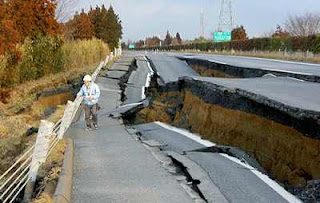The earthquake damage in Japan was limited, partly because of the epicenter was almost 100 km from shore, but mostly due to the building codes that Japan has in force. Japanese building codes are more restrictive than those in the US as they call for building designs that are stronger and consequently more expensive. This philosophy appears to have paid off as we have not seen the collapse of any engineered buildings. While ground motion values may have been minimized by the distance of the epicenter, this was a very long duration earthquake, which is common for subduction zone events. Long duration shaking is something we may not have fully accounted for in our building codes and may have worked some building components to the point of failure where shorter shaking duration would not have. The only building collapses we have seen so far have generally been of older wood residential buildings. Japanese home construction traditionally uses heavy tile roofs for protection from typhoon winds. However, these heavy roofs can overtax a wood frame home if it is not properly built or maintained.
While Japanese structures performed very well in the earthquake, we have heard many reports of damage to non-structural components, which are the building’s architectural elements, utilities, contents, etc. This type of damage continues to be a problem that we have documented in every earthquake, and is often responsible for greater dollar losses than actually structural damage. This type of damage often also results in the loss of function of the facility. A common example of this type of damage is damage to piping, such as fire sprinkler heads breaking from ceiling impact. This type of damage to a critical facility such as a hospital, this can greatly impact a community’s response and recovery. For residential buildings, this type of damage can include a water heater falling over if not strapped to a wall or the collapse of shelving or cabinets.
to be a problem that we have documented in every earthquake, and is often responsible for greater dollar losses than actually structural damage. This type of damage often also results in the loss of function of the facility. A common example of this type of damage is damage to piping, such as fire sprinkler heads breaking from ceiling impact. This type of damage to a critical facility such as a hospital, this can greatly impact a community’s response and recovery. For residential buildings, this type of damage can include a water heater falling over if not strapped to a wall or the collapse of shelving or cabinets.
 to be a problem that we have documented in every earthquake, and is often responsible for greater dollar losses than actually structural damage. This type of damage often also results in the loss of function of the facility. A common example of this type of damage is damage to piping, such as fire sprinkler heads breaking from ceiling impact. This type of damage to a critical facility such as a hospital, this can greatly impact a community’s response and recovery. For residential buildings, this type of damage can include a water heater falling over if not strapped to a wall or the collapse of shelving or cabinets.
to be a problem that we have documented in every earthquake, and is often responsible for greater dollar losses than actually structural damage. This type of damage often also results in the loss of function of the facility. A common example of this type of damage is damage to piping, such as fire sprinkler heads breaking from ceiling impact. This type of damage to a critical facility such as a hospital, this can greatly impact a community’s response and recovery. For residential buildings, this type of damage can include a water heater falling over if not strapped to a wall or the collapse of shelving or cabinets.
The tsunami generated by this earthquake was measured as high as 33 feet (10 meters) and was responsible for most of the damage and fatalities that we are now seeing. It was the first tsunami to strike a modern, developed coastline, and it was devastating. While Japan generally incorporates seawalls and other structural protection to protect most developed areas, this tsunami overwhelmed all of these defenses. The tsunami reduced most of the wood frame homes to kindling. However, there were also some examples of larger, heavier multi-story concrete structures that survived the tsunami.



No comments:
Post a Comment